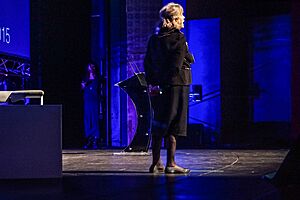Susan McKenna-Lawlor facts for kids
Quick facts for kids
Susan McKenna-Lawlor
|
|
|---|---|

Susan McKenna-Lawlor in 2015
|
|
| Born | 3 March 1935 |
| Nationality | Irish |
| Alma mater | University College Dublin |
| Scientific career | |
| Fields | Planetary science, Experimental Physics |
| Thesis | A Detailed Study of Phenomena Attending the Disk Passage of an Exceptionally Active Solar Region, 7–21 July 1959 (1976) |
| Doctoral advisor | T.E. Nevin |
Susan McKenna-Lawlor, born on March 3, 1935, is a famous Irish scientist. She is an astrophysicist, which means she studies space and the universe. She used to be a professor of experimental physics at Maynooth University. She retired from her teaching role in 2000.
Contents
Early Life and Learning
Susan was born in Dublin, Ireland, on March 3, 1935. She loved science from a young age. She went to University College Dublin to study experimental physics. She earned her first degree in 1956, then a master's degree in 1959, and finally her PhD in 1976.
From 1957 to 1966, Susan worked as a research assistant. This was at the Dublin Institute for Advanced Studies. Her PhD research looked closely at what happens on the Sun. She studied a very active part of the Sun in July 1959.
After getting married, Susan McKenna-Lawlor became a lecturer. This was in the early 1970s at St. Patrick's College, Maynooth. She became a full professor there in 1986.
Space Technology Ireland Ltd
In 1986, Susan McKenna-Lawlor started her own company. It is called Space Technology Ireland Ltd (STIL). She created it with a business investor named Dermot Desmond. STIL makes special tools and equipment for space missions. Susan McKenna-Lawlor is the managing director of this company. STIL was set up on the campus of St. Patrick's College, Maynooth.
Space Research and Missions
Susan McKenna-Lawlor has been a very important part of many space missions. She has worked with space agencies from different countries.
Giotto Mission
She was the main scientist for an experiment called EPA. This experiment was on the European Space Agency (ESA) Giotto mission. The Giotto spacecraft flew close to Halley's Comet in 1986.
Phobos Program
In 1988, Susan McKenna-Lawlor led a group of scientists from around the world. They built a special detector for the Soviet Union's Phobos spacecraft. This detector could find tiny particles in space. It was a big success. Because of this, Soviet scientists asked her to help with their 1994 mission to Mars.
Cluster Mission
She also helped with another ESA mission called Cluster. For this mission, she was a Co-Investigator for an experiment called RAPID. The Cluster mission uses four spacecraft to study Earth's magnetic field.
Mars Express Mission
Susan McKenna-Lawlor also helped develop tools for the ESA Mars Express mission. These tools were used to check the solar wind on Mars. The solar wind is a stream of particles from the Sun.
Rosetta Mission
Her company, STIL, designed a special computer unit for the Rosetta spacecraft. This unit helped control the spacecraft. Susan McKenna-Lawlor also represented Ireland on the board for Rosetta's Philae lander. The Philae lander made history when it landed on comet 67P/Churyumov–Gerasimenko.
Awards and Special Recognition
Susan McKenna-Lawlor has received many awards for her amazing work.
- In 1986, she won the Rehab People of the Year Award.
- She was chosen to be a member of the International Academy of Astronautics. This is a group of top space experts.
- In 2005, she received an honorary DSc degree from the University of Ulster. This was to honor her important contributions to astrophysics.
She was also a member of the National University of Ireland Senate. She served on Maynooth University's Governing Authority too.

